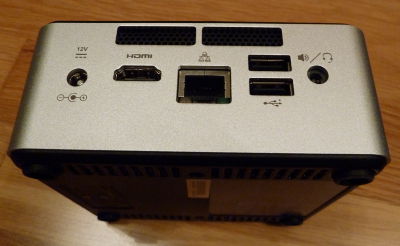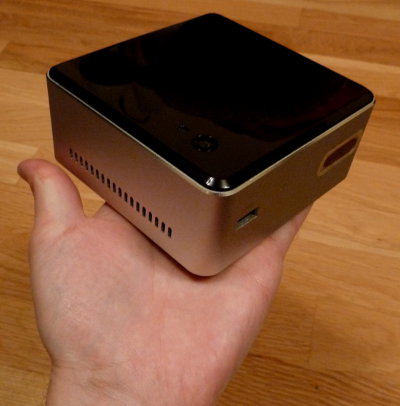Intel NUC as a home server
By now you may have read my posts about finding and choosing an online backup service. Those cover the part about off-site backups. I’m also making changes to the way I do on-site backups. Recently, I bought an Intel NUC, model DN2820FYK that I’m using as my home server for that purpose.
Maybe I’m out of touch with the low-power PC community, but I only recently found out about these devices, which are one of the few ways to get your hands on a low-power Intel processor powering a “normal” PC, be it either a Bay Trail-M processor or a Haswell lower-power processor with the U or Y suffixes. The most efficient ones always use BGA and can’t be bought on their own.
So the solution Intel gives you are these NUCs. They’re aimed at the hobbyist market, because it requires work on your part, but at the same time they’re very easy to set up. You just need to buy the kit, a DDR3L memory stick (only one slot is available and the L is very important) and a 2.5" SATA hard drive. Optionally, a wifi adapter or antenna, I think, if you want to use wifi instead of its wired Gigabit port. You can then install an OS and use it as a normal computer by connecting it to an HDMI screen, USB mouse and USB keyboard.
Regarding the hard drive, all models come with a SATA connector, I think, but only the ones with taller boxes have room enough to fit a 2.5" hard drive inside. For some uses, the smaller models save space and can be booted from a USB stick in any case.
The following image shows the back of my device, with sockets for power, HDMI, Ethernet, USB 2.0 and audio.
And this is the front of the device. As you can see, it’s a bit bigger than my hand. The socket on the front is a USB 3.0 port.
Compared to my Raspberry Pi, it has the following disadvantages:
-
It’s more power hungry. The CPU itself uses 7.5W but the whole box by itself has a 36W power supply, while a Raspberry Pi with a hard drive typically needs 2A from its 5V USB power socket, that is, 10W.
-
It’s more noisy. Noise is one of the few slightly disappointing aspects of the device. I was genuinely expecting an almost silent PC. The noise is more of a whisper than anything really, and the hard drive inside makes more noise when reading or writing data, but it’s not silent as we’ve been spoiled to expect from mobile phones, ultrabooks and some workstations. I believe the noise comes from the power supply. I would have zero problems sleeping in the same room it’s in.
-
It’s cheap yet obviously more expensive. The kit plus the 4 GB memory stick plus a hard drive would cost you about $250.
But it has the following advantages:
-
First off, it’s an Intel x86_64 computer with an Intel graphics chip, bluetooth, wifi, gigabit network, etc. While the CPU itself is a single core 2.x GHz chip and may not run Crysis smoothly, this is insanely more powerful than a Raspberry Pi.
-
As a consequence of the previous point, you can install almost anything on it. For example, I installed Slackware Linux like I have in my desktop computer, with the network installation option by booting from USB. Notice this thing supports EFI booting with Secure Boot, but also has a legacy BIOS mode if you want to to avoid any trouble.
-
It supports way more RAM. I bought a 4GB stick but you could go with 8GB too. More than enough for a home server of almost any kind.
-
The SATA connector makes it possible to monitor the hard drive using SMART and maybe get a warning when the disk is about to fail. As far as I know, you can’t monitor SMART over USB in a standard way, which is a minor grief I had with my Raspberry Pi. Some Windows programs let you do it using nonstandard mechanisms, but under Linux you’re out of luck. If I’m wrong on this, please let me know in the comments. It’s a very interesting topic.
-
It comes with a proper box, a board to mount it on the back of a TV, a proper power supply and includes a DC adapter with interchangeable plugs. No additional purchases needed in this regard.
The PC market may be dying, or at least shrinking, but I’m very glad Intel is selling these kits and I hope they continue to do so with future CPU models and microarchitectures. When the desktop computer I’m typing this text in dies, I think I’d be delighted if I could buy one of these to serve as my workstation. Right now the CPUs powering them are a bit underpowered, but Intel should be able to create, in a few years, a 2.5GHz low power quad core CPU suitable to be put inside one of these boxes.

